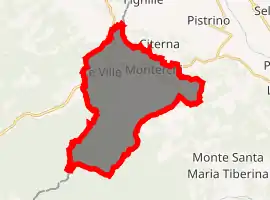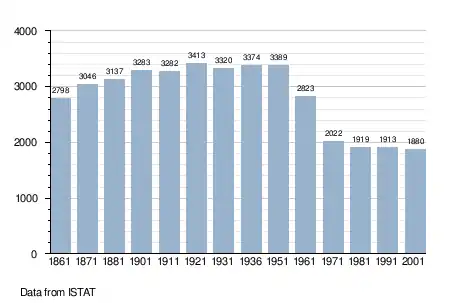Monterchi
Monterchi is a Comune (Municipality) in the Province of Arezzo in the Italian region of Tuscany, located about 80 kilometres (50 mi) southeast of Florence and about 20 kilometres (12 mi) east of Arezzo. It sits in the northern part of Valtiberina (The Tiber Valley), the valley where the Tiber river runs going from Emilia-Romagna (where it originates from the Mount Fumaiolo) towards Rome. The valley runs through Romagna, Tuscany and Umbria, parallel to the Casentino Valley.
Monterchi | |
|---|---|
| Comune di Monterchi | |
 | |
 Coat of arms | |
Location of Monterchi 
| |
 Monterchi Location of Monterchi in Italy  Monterchi Monterchi (Tuscany) | |
| Coordinates: 43°29′N 12°6′E | |
| Country | Italy |
| Region | Tuscany |
| Province | Arezzo (AR) |
| Frazioni | Borgacciano, Le Ville, Padonchia, Pianezze, Pocaia, Ripoli, Fonaco |
| Government | |
| • Mayor | Alfredo Romanelli |
| Area | |
| • Total | 28.7 km2 (11.1 sq mi) |
| Elevation | 356 m (1,168 ft) |
| Population (2017)[2] | |
| • Total | 1,742 |
| • Density | 61/km2 (160/sq mi) |
| Demonym(s) | Monterchiesi |
| Time zone | UTC+1 (CET) |
| • Summer (DST) | UTC+2 (CEST) |
| Postal code | 53035 |
| Dialing code | 0575 |
| ISTAT code | 051024 |
| Saint day | October 8 |
According to census data updated on Jan. 2017, the city's population was 1,742 while the Comune covers an area of 28.7 square kilometres (11.1 sq mi).[3]
Monterchi borders with Anghiari, Arezzo, Citerna, Città di Castello, Monte Santa Maria Tiberina.
The name Monterchi (Mons Herculis - "Mount of Hercules"), seems to originate from a legend stating that the half-god Hercules founded Monterchi after beating the Hydra, a mythological monster with several heads. The history is still depicted in the coat of arms of the city's banner.

The most famous cultural attraction of Monterchi is the fresco of the Madonna del Parto by Piero della Francesca, painted between 1450 and 1465 in honour of the painter's mother, Romana di Perino da Monterchi, who was born in town and is in the Museo della Madonna del Parto di Piero della Francesca.[4]
The Town
Monterchi was originally a medieval town, perched on a hill overlooking the beautiful Tuscan countryside which spreads around in every direction. What remains of the great walls once surrounding the small village, traditionally built to protect inhabitants and assets from invasions and attacks by ravagers, let Monterchi maintain part of the suggestive appearance of a fortified town. Also some of the characteristics alleys typical of the towns built in the Middle ages are still visible, and they now provide shade from the hot Tuscan sun, while they used to be safer to guard and protect than larger ones in case of attacks.

Unfortunately, some violent earthquakes significantly destroyed the original structure of the town, among them, the most violent ones were the one in 1352 (measuring 6 on the Richter scale)[5] and the last one, on April 26, 1917.[6] This is the reason why the medieval structure of the town only partially remains today and most of the buildings were built after 1917, like the town hall by Giovanni Michelucci, in the main square of the town.
The new town has developed at foot of the hill, where the main street to go either to Arezzo or to Sansepolcro and Umbria runs.
Also at foot of the hill, the Cerfone is a stream along which cultural and gastronomic festivals are held during the summer, like the Polenta Fest, which takes place in September.
Main sights
The best view of the countryside surrounding Monterchi, full of fields of sunflowers and tobacco cultivation is the panoramic terrace of the Rocca (the ancient Fortress), up in the old part of the town.

The main attraction of the town is though the Museo della Madonna del Parto di Piero della Francesca where the Madonna del Parto fresco by Piero della Francesca is displayed after being taken down from the wall of the Chapel of Santa Maria di Momentana by the local cemetery.

Interesting is also The Scales Museum, house of one of the most important collections of scales and weights in Europe.

Many are the churches worth a visit. The first one is

the Church of San Simeone, dating back to the Middle Ages. In 1830 it has been completely demolished and rebuilt and it was subsequently seriously damaged by the earthquake in 1917. It hosts a wooden crucifix and a ciborium in polychrome terracotta from the 15th century and a stone pulpit depicting Hercules killing the Hydra from the 16th century.
The Church of San Michele Arcangelo (St. Michael the Archangel) is a little outside the center of town, in the hamlet of Padonchia. It hosts many paintings depicting various saints such as St. Christopher and St. Sebastian, a noteworthy work depicting che Archangel Michael battling against the devil and ancient architectural elements such as four figured corbels sustaining the vault of the Presbitery. A Madonna and Child from the first half of the 1400s is also worth the visit.
Another Church dedicated to St. Michael the Archangel can be found in the nearby hamlet of Pianezze. Built in romanesque style, the Church has a wooden ceiling and a terracotta floor. The main attraction is the fresco painting depicting the "Madonna della Misericordia" (Holy Virgin of Mercy) from the 16th century and a "Pietà" in polycrome terracotta.

The romanic church of St. Apollinare dates back to the 7th/8th centuries and it holds the typical romanic structure: a nave, a semi-circular apse and a gable. The latter has then been decorated in the Seventeenth century.
The Church of St. Mary in Scandolaia, another hamlet near Monterchi, lies near the ruins of the Montagutello castle, on the slopes of Mount Felcino. It's maybe the oldest Church in the area, dating back to the 12th century. The wooden sculpture of the Madonna and Child which originally decorated the Church has now been moved to the Church of Le Ville.

The Church of San Benedetto is part of a monastery that is said to have been built on the foundations of a preexisting hospital for wayfarers and sick men. The Church was completely renewed in the 16th century after the monastery had been destroyed during a local war. In 1840 the Church was renewed again by adding the columns at the entrance and the decorations on the facade, the plaster decoration of the interior and the marble altar.
The Church of the Madonna Bella (Beautiful Virgin Mary) is in Pocaia, and was originally built around the first half of the 16th century to be an oratory dedicated to the Holy Virgin. It hosts a beautiful terracotta in the style of Andrea Della Robbia which is believed to protect from car accidents.

Coming to more recent works, a significant palace within Monterchi is certainly the Town Hall, a project by the famous Florentine architect Giovanni Michelucci which has long been forgotten to be his creature, probabily even by himself. Built right before World War II, the paternity of the building has only recently made known to the public at large.
Monuments and cultural sites
Churches
- Chapel of Santa Maria di Momentana
- Church of Sant'Apollinare
- Church of San Simeone
- Church of San Benedetto
- Church of San Michele Arcangelo (St. Michael the Archangel) in Padonchia
- Church of San Michele Arcangelo (St. Michael the Archangel) in Pianezze
- Church of the Madonna Bella (Beautiful Virgin Mary)
- Church of Santa Maria in Scandolaia
Theaters
- Community Theater
Buildings
- Town Hall
Demographic evolution

References
| Wikimedia Commons has media related to Monterchi. |
- "Superficie di Comuni Province e Regioni italiane al 9 ottobre 2011". Istat. Retrieved 16 March 2019.
- "Popolazione Residente al 1° Gennaio 2018". Istat. Retrieved 16 March 2019.
- All demographics and other statistics: Italian statistical institute Istat.
- Spiegelman, Willard (12 October 2018). "On the Brink of the Savior's Arrival". Wall Street Journal. Dow Jones & Company, Inc. Retrieved 18 June 2019.
- Ciaccio, M.G.; Palombo, B.; Bernardi, F.; Ferrari, G.; Perniola, B. (12 September 2008). "Historical and Instrumental Seismicity of the Sansepolcro Basin, Northern Apennines, Italy" (PDF). Core.ac.uk. Retrieved 18 June 2019.
- Caciagli, Marco; Pucci, Stefano; Batlló, Josep; Cesca, Simone; Braun, Thomas (27 February 2019). "Did the Deadly 1917 Monterchi Earthquake Occur on the Low‐Angle Alto Tiberina (Central Italy) Normal Fault?". Seismological Research Letters. GeoScienceWorld. 90 (3): 1131–1144. doi:10.1785/0220180155. ISSN 1938-2057.